Saskatoon to Montreal: Testament to vastness Boy, was it ever!
We have made several road trips across Canada and yet we are surprised at what we encounter. Hamlets that are known only to a relatively few people turn up igniting a yearn to explore. Alas, the roads that lead to them may not be paved and when you are on a schedule you don't want to take risks. This sign board in Ontario appeared on the Trans-Canada ( the T-can) on our road trip from Saskatchewan to Quebec. What will it lead too?!
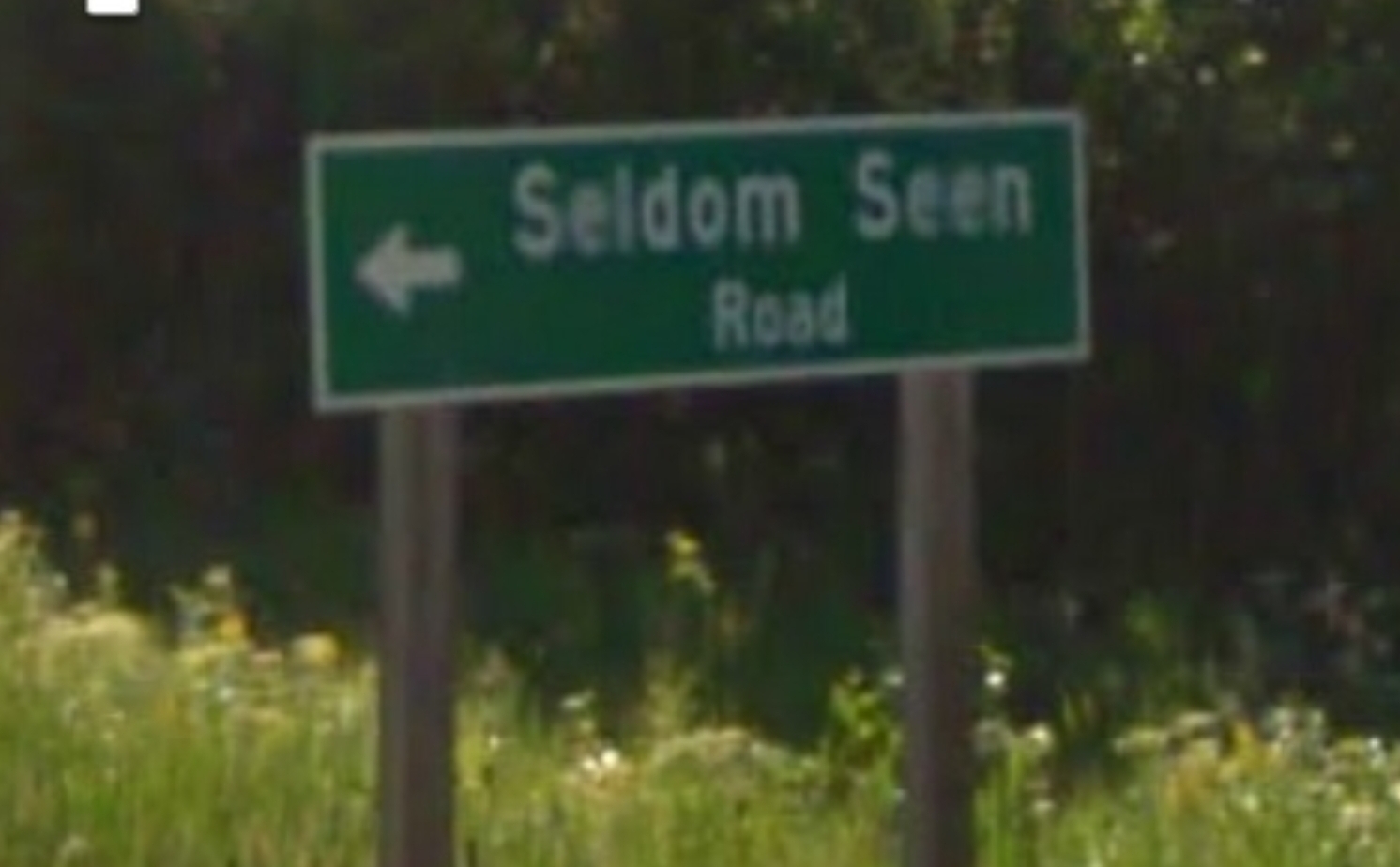
Bucolic beginning:Saskatoon to Regina
This is the shortest leg of our journey. It's nearing autumn. We pass by the posh residential area in Saskatoon. The glowing sun has a midas touch over the vast wheat fields that follow. The hay has been cut and bundled into neat rolls. The soya, canola,sunflower and corn fields are full of promise. The cows and the horses contentedly graze the gleanings.
The last few days have been physically tiring. What better way to stretch our legs and have a breath of fresh air than to stop for tea in a grove? Davidson, Saskatchewan, has the perfect spot.
And then we see the sign board for Findlater! Is it a favourable sign? We will find out later.

Regina to Portage La Prairie: lower speeds
After a very relaxing night at Travelodge and a highly satiating continental breakfast we resume our journey.
More harvesting and neat cubes of straw bales stacked high. An ever so long goods train passes by. We cross the border into Manitoba, bypass Brandon and Winnipeg. In Saskatchewan highway speed is generally 110km/h. Not so in Manitoba. Only 100km/h. But with towns, bends, 2-way lanes and road works we are much slower.
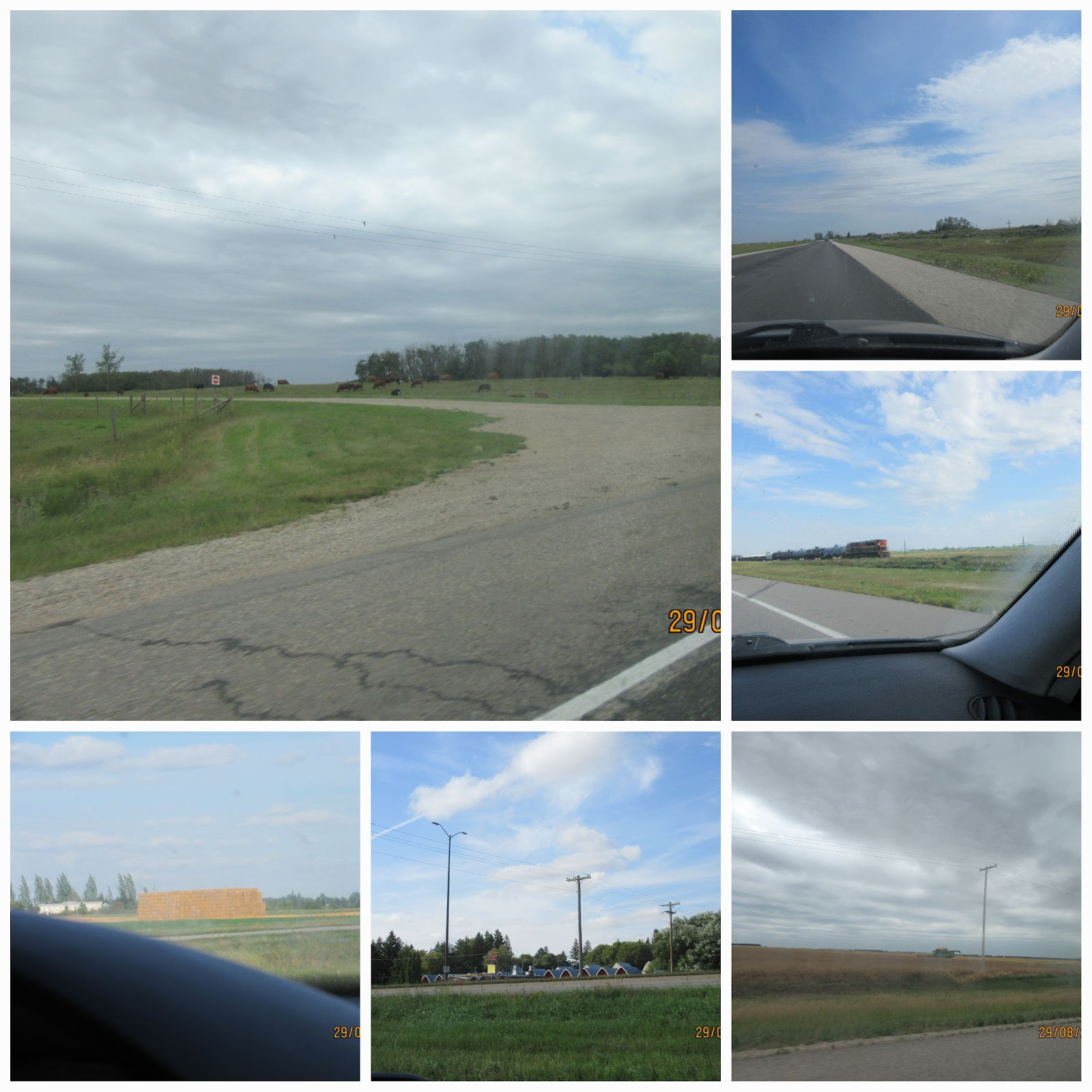
Portage La Prairie to Thunder Bay: A good start
Another good night's sleep in a beautiful, one of a kind resort-like hotel (CanadInns) and a hearty continental breakfast ( a surprise gift for August guests)and we are in full holiday mode.
Just behind the hotel is the world famous coke can. The relocated curiosity was actually a 26m water tower built in 1905. Relocated to the present site it was rebranded by the Coca-Cola company. We couldn't resist visiting the historic railway station. We are well aware that we have a terribly long way to go.
Change is in the air
The rolling prairies are now slowly giving way to rugged country. At some points there are road blocks warning us of rocks being blasted to make way for wider roads. The Trans-Canada, two way for the most part, has passing lanes every 10 km or so. We drive conscientiously slightly under the recommended 100km/h. And so we lead a very long line of cars and an unbelievable number of juggernauts just rearing to go at the next passing lane. And when we are at that point they whizz past us. Counting them becomes an amusement. We can't help but notice that the daredevils are mostly Ontario registered vehicles!
We skip Kenora, a beautiful town along the shores of Lake Superior, for we simply must get on.
Visual treats
Our route follows the contours of Lake Superior for the most part with every curve or hill offering us a view of blue waters whether of some smaller lake or that of the largest. Some lakes we cut across on causeways. We discover West Beach, the lake waters ruffled by the strong chilly wind, because we needed to use the amenities. We spotted a windmill (apparently a tourist attraction) from afar.

Can we make it?
Once we cross into Ontario the speed limit reduces further to 90 km/h due to the rugged terrain. For what seems like hours we pass between large walls of roughly hewn boulders. Again we create a chain of vehicles behind us until they can safely pass. Ominous clouds appear on the horizon. We planned to reach Thunder Bay before sunset but it's not going to happen because of the speed limit, as well as stopping almost every hour for gas, for there's no guarantee that you'll find a gas station when you need it. The towns are about an hour apart and their population is generally less than 1000.
Nerve wracking
It rains intermittently. At one point it picks up and our wipers go full speed. The splash and spray from passing trucks blind us. We drive with our hazard lights on. The sun is obliterated by the dark clouds. We have our headlights on. Oncoming drivers do not always dim their lights in response to ours. About one hour into this sticky situation the rain let's up. We breathe a sigh of relief only to be greeted by a series of lightning. And then all hell breaks loose.
The night seems to be loaded with omens. Blinding sheet rain that wipers found difficult to swipe off. The grieving skies pound on the roof. Would our sun roof leak? It's beginning to steam up in the car. No amount of vigorous wiping is fast enough to clear even a small portion of the glass. Signs that warn of the danger caused by moose at night appear. And then the rain lets up a little. We turn on the heat to keep the glass from misting up and pick up speed. Even then trucks and cars are nonchalantly passing us.
Nail biting
The rain picks up again. Within a few minutes we hear a loud snap. Did we drive over something? Did something fall on us? No! The wiper on the driver's side has snapped off due to fatigue. It is certainly not wise to stop a car and search for the blade in the gathering darkness, especially when traffic shows no indication of stopping for a car with hazard lights on.
The lighting continues. The rain drops to a drizzle. We have already passed Dryden where we topped up our fuel tank. A truck stop along the way did not have wipers that met our needs.We are a long way from there. Taking a huge risk we manage to drive past Upsala, until we find one lonely light at what could have been a motel. We stop under the light to inspect the wiper. Only the blade has snapped off. So we try to replace it with the one on the passenger side. We are getting wet and the catch refuses to budge.
A friendly hand
An elderly man is out walking his dog. He's reluctant to talk to us at first and then he sizes us up, apologises and asks if we need help. He gets his engineer son from probably one of the motel rooms. He manages the snaps and the switch is done. The older man tells us of how he and his son were on a boat on Lake Superior that evening when the weather worsened and they began to rock dangerously.
We have 130 km to go. Now the rain has petered down to reluctant drops and so we resume our drive. The driver can see ahead of him but not the passenger. The rain hasn't done with pelting us. Within a few minutes the other wiper too gives up and rests neatly along the hood. We have taken enough risks for the day.
Distress of highest priority
Should we just have asked for a room at the motel we had stopped by, assuming it was a motel? Anyway turning around in poor visibility would just be too risky. Traffic is still passing us. We decide to pull out onto the apron and wait for the rain to stop. It does look as though the skies are determined to test us. We call CAA. There is no tower signal! Luckily we have an alternate Telco. That works. Once we give the agent our approximate position and our problem he puts us on the highest priority. We get a message that CAA does not replace wipers but will tow us to our destination. It will take the truck 2 hours to reach us. It's 11pm now. We'll have to wait till 1 am. Having been at the edge of the seat for nearly an hour I lean back to try and sleep. We keep the seat belts on. But the driver is agitated. We have to keep our hazard lights on for nearly two hours. A moose might just come and nudge us. We are on the apron but trucks that whizz past can nudge us into whatever was on the passenger side– a ditch,a lake, a creek? We don't have a caution tape for the side of the car.
Make a dash
Within 20 mins the rain let's up. We make another bold decision. We don't need wipers now. We pull out carefully, pick up speed with a plan to get as close to Thunder Bay as we can. We call ahead so that we can check into our motel as soon as we arrive. This time we drive faster, but still below the speed limit. All along the way I'm peering at the mile markers to see how far we have come from the Manitoba border. Seeing the numbers increase gives us more confidence though I have to again sit at the edge of the seat and look keenly into the darkness before the headlights light up the numbers.
A pat on the back for the driver
We have made it! We call CAA, much before they have even texted us about the estimated time of arrival, for the tow to cancel the assignment.
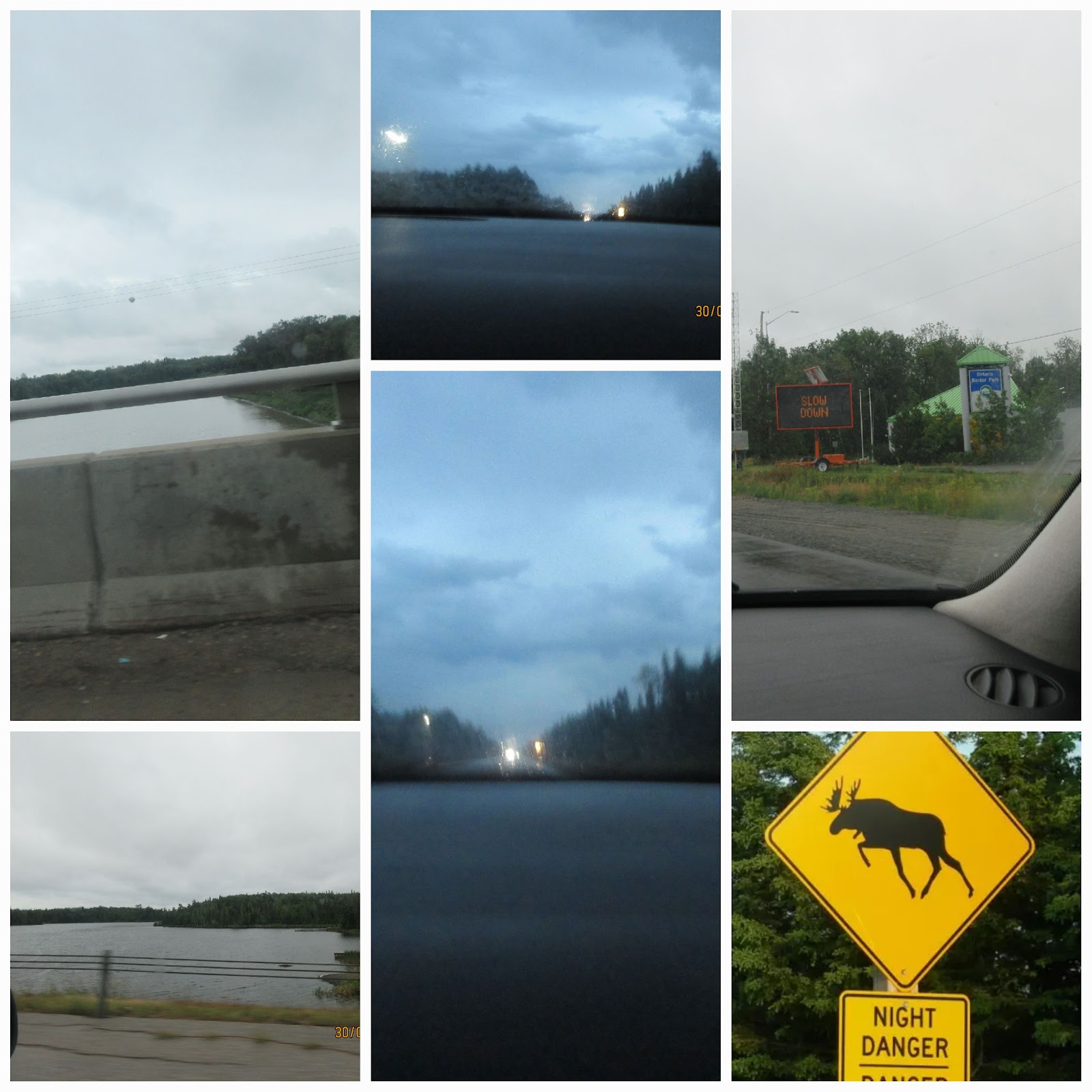
Thunder Bay to Sault Ste Marie
It must have been providence that we had booked two nights in Thunder Bay. Enough time to get over a gruelling night in hazardous driving conditions. When well rested we drive up to Terry Fox Memorial park, from where we watch the Sleeping Giant slumbering in the sparkling waters of Lake Superior and have a glimpse of the American side of the great lake.
Luck favours us today
We purchase a wiper to replace the one we lost. We struggle with it when a passerby asks if we could manage and we proudly think so. After half an hour of struggling with a newfangled catch we are glad to have another passerby assist us. He is not one to give up. He tries out the different clasps and decides that the one we were trying on was the best fit. He too has to give up. How could a simple clasp be so mind-boggling? So we simply walk into the service centre to pay an expert to fix it for us. No one was available. The salesperson at the checkout counter took it upon himself to show us how to unlock the clasp. It was so simple. So in no time at all we had our windshield wipers back on at no extra cost!
Something I never knew
That evening we take a stroll to the Current River Dam. The Lakeshore Walk along Boulevard Lake created by the dam is calming. Its unique feature is the fish way/ladder, the very reason for the building of the dam. It is designed to allow Steelhead (trout) to migrate over the dam into the headwaters, and hopefully to produce a large stock.
And then we meet a friendly elderly gentleman who points behind him and talks about how tall the plants are and how alive they become in Spring.
It's a butterfly park fully taken care of by volunteers. There are very few butterflies now it being almost the end of summer. It is wonderful to see gardening equipment laid out neatly. Any responsible volunteer interested in the pollinator garden could manually help maintain the premises.
The next morning we begin our next leg.
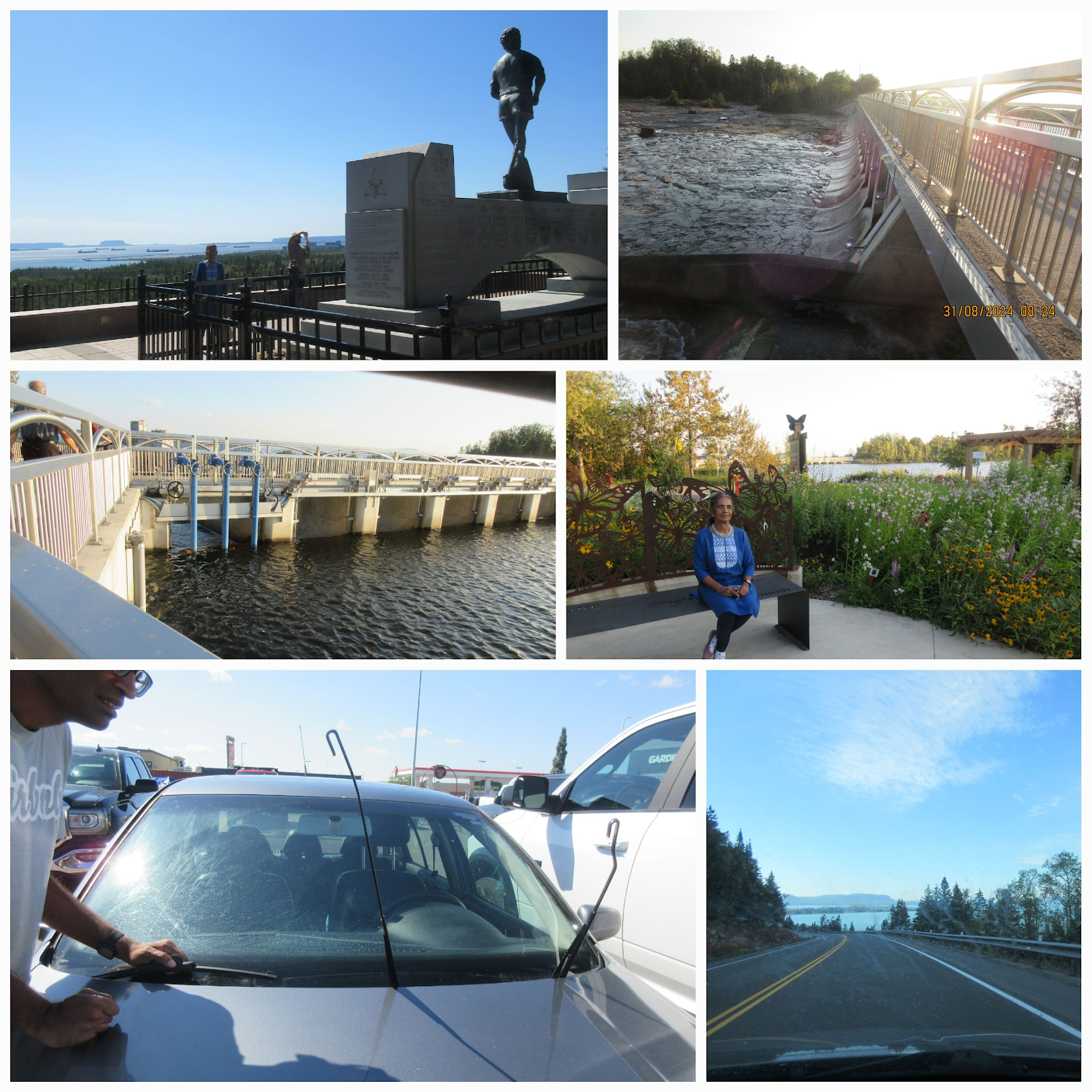
Sault Ste Marie to North Bay
Soo ( that's how Sault is pronounced) delights us with its lock system. The ancient buildings, such as the superintendent's office, still stand though put to other uses. The renovated part of the canal is now used for leisure. It is fascinating to watch a tour boat rise in the canal from Lake Huron, the eddy created as the water rose becoming a playground for the duck that shows off his acrobatics. And then when the gate opens , the boat glides into the higher Lake superior. The canal, once the longest in the world, helped bypass the rapids on St. Marys River that connected the two lakes. Besides just above us is the bridge that connects to the USA.
After this refreshing walk we continue our drive towards North Bay. We stop for a break at a small building in a sylvan setting on a bay. A beautiful watercolour painting of flowers in autumn colours catches my eye. Beside the painting is a used watercolour paint set and brushes. It is a painting by one of the famous Group of Seven landscape painters! As we pass through the town centre we see an attractive light house which is a replica of the one on Lake Superior. Apparently there is a good view of the famous lake from the top of this structure.
We stopped in Marathon for a refill when we noticed directions for White Pebble beach. Why not? It certainly lived up to its name. It's a steep walk down to the beach along Lake Superior. The waters are crystal clear!

North Bay to Montreal
The sunset at North Bay near the Marina is beautiful. We have almost left the rugged terrain of the Canadian Shield. At Mattawa we are attracted to the Service Ontario building standing proud at an intersection. The building has information and clean washrooms. We continue towards Ottawa stopping by a picnic area. A unique camper trailer comes by. We are guessing it's German! On again towards Ottawa passing by picnic areas and beautiful towns on the shores of rivers and lakes. And then the border into Quebec. Traffic seems to be a mess.Within an hour we are at our hotel right next to the Montreal central library.
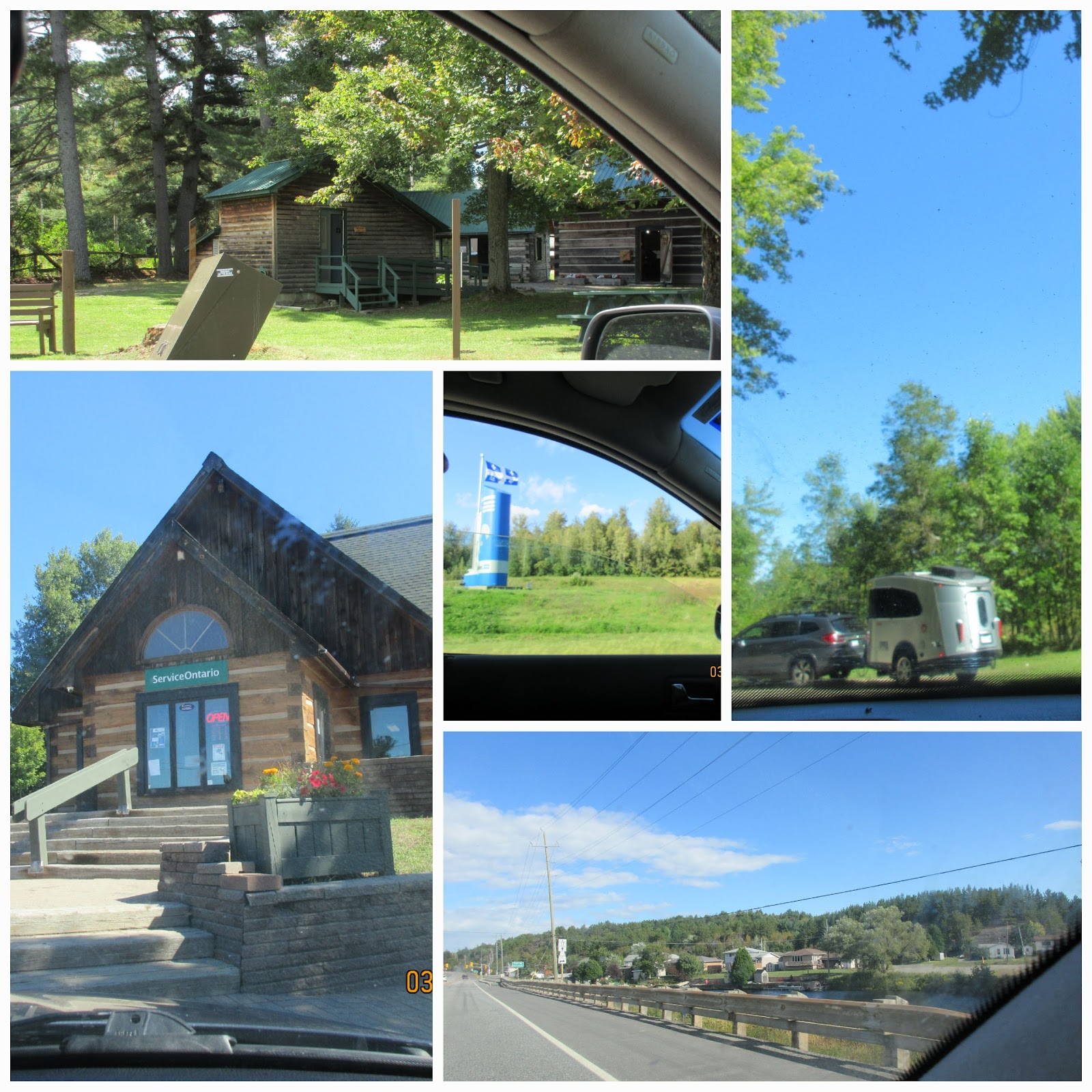
Takeaways:
All along sign boards have indicated we've been close to the US border, the longest undefended border in the world, longer than the Nile.
We've driven across 4 provinces for nearly 3500 km over 7 days. In a trip done nearly 13 years ago we drove from Saskatchewan to New Brunswick and back over 2 weeks. A few years ago we did one from Saskathcewan to British Columbia and back over 8 days ( covered in a previous blog): No surprise for Canada is second only to Russia in size. The Trans-Canada goes from the Pacific Coast to the Atlantic Coast
Lake after lake: Canada has the greatest number of lakes in the world. 50% of the freshwater lakes of the world are in Canada. Its largest is Lake Superior which is second only to lake Baikal
Winning-the-Pooh: Winnie was the nickname for Winnipeg Bear donated to the London Zoo by a Winnipeg Soldier/vet who bought the cub in White River, Manitoba.

Signs that autumn has begun.










